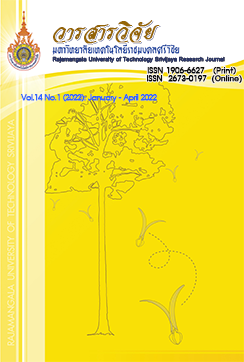Design and Fabrication of Lotus Seeds Sizing Machine
Keywords:
design, sizing machine, lotus seed, lotusAbstract
The lotus seeds sizing machine was designed and fabricated to study and test factors affecting the grading of lotus seeds. The machine consists of a main frame, a hopper, a seeds sizing unit, a power transmission unit, and a 1 hp electric motor which was used as a prime mover. In the operation, the lotus seeds were fed manually into feeding chute on the top of the machine, then the seeds fell through the seed sizing unit which composed of 3 cylindrical sieves that served for grading into 3 sizes. After that, seeds were released through outlet chute at the front of the machine. The prototype was tested for 3 different sizes of feeding, and at the seeds sizing unit speed of 20, 25 and 30 rpm, respectively. It indicated that the optimal performance was achieved when the machine was operated at seeds sizing unit rotational speed of 25 rpm (Linear speed of the screen for grading is 0.67 m/s), using large size of feeding (15×10 cm2) with feeding rate of 330 kg/hour. The working capacity was 128.2 kg/hour and the percentage of grading was found to be 92.1% with no percentage of damaged seeds. It consumed 0.33 kW-hour of energy.
References
Anonymous. 2017. Lotus production situation. Bangkok. Department of Agriculture Extension. Available Source: http://www.
doae.go.th/LIBRARY/, Jul 9, 2018. (in Thai)
Jolly, RS. 2018. Benefits of the lotus plant. Mumbai. Available Source: https://caloriebee.com/nutrition/Health-Benefits-Of-Lotus-Roots-Or-Stem-Seeds-Leaves-And-Flowers, January 25, 2019.
Krutz, G., Thomson, L. and Claar, P. 1994. Design of agricultural machinery. 1st ed. John Wiley and Sons, New York.
Langkapin, J., Parnsakhorn, S. and Akarakulthon, P. 2015. Development of a dry lotus seed sheller. Thai Society of Agricultural Engineering Journal 21(1): 38-44. (in Thai)
Langkapin, J., Parnsakhorn, S., Kalsirisilp, R., Prorod, M. and Khotpromsrt, N. 2018a. Study and testing of a lotus seed peeling machine. Journal of Engineering RMUTT 15(1): 35-42. (in Thai)
Langkapin, J., Parnsakhorn, S., Kalsirisilp, R. and Sangsawang, S. 2018b. Development of a dried lotus seed sheller. Research Journal RMUTT 17(2): 11-22. (in Thai)
Langkapin, J. 2018. Solidworks. 3nd ed. Triple Education Co., Ltd, Bangkok. (in Thai)
Langkapin, J., Parnsakhorn, S., Kalsirisilp, R., Samseemoung, G., Ngmanil, P. and Juey, T. 2019. Design and fabrication of a lotus seed membrane peeling machine. Journal of Engineering RMUTT 17(1): 127-137. (in Thai)
Langkapin, J., Parnsakhorn, S., Kalsirisilp, R., Samseemoung, G., Pookamkong, M. and Suwanwijit, P. 2020. Study and testing of lotus seeds sizing unit. Journal of Engineering RMUTT 18(1): 121-129. (in Thai)
Mueangsuk, S. 2016. Lotus farming in Bueng Kan. Bangkok, khaosod Online. Available Source: https://www.khaosod.co.th/view_n
ewsonline.php?newsid, Feb 15, 2016. (in Thai)
Shigley, J.E. and Mischke, C.R. 1989. Mechanical engineering design. 5th ed. McGraw-Hill Book Company, USA.
Suwannaro, T. 2007. Lotus farming. Extension and Training Office. Kasetsart University, Bangkok. (in Thai)
Suksawat, W. 2017. 7 benefits of Thai grains. Bangkok. Available Source: http://www.tnews.co.th/contents, April 23, 2018. (in Thai)
Vijitwittayapong, P. 2013. Lotus seeds product of Phichit. Bangkok, Matichon Online. Available Source: http://www.matichon.co.
th/matichon/view_news, Feb 13, 2013. (in Thai)
William, H. and George, W.L. 2005. Official methods of analysis of AOAC International. 18thed. AOAC International, Texas.
Downloads
Published
How to Cite
Issue
Section
License
Copyright (c) 2022 Rajamangala University of Technology Srivijaya Research Journal

This work is licensed under a Creative Commons Attribution-NonCommercial-NoDerivatives 4.0 International License.
The content and information in the article published in Journal of Rajamangala University of Technology Srivijaya It is the opinion and responsibility of the author of the article. The editorial journals do not need to agree. Or share any responsibility.







